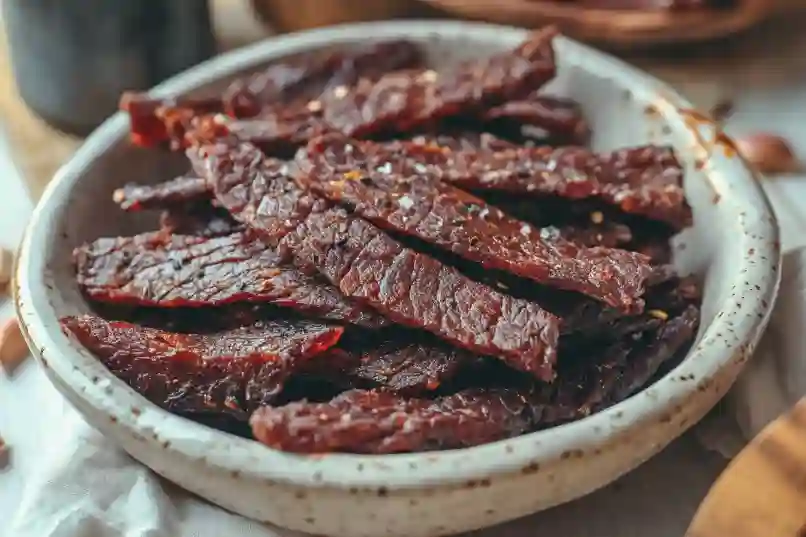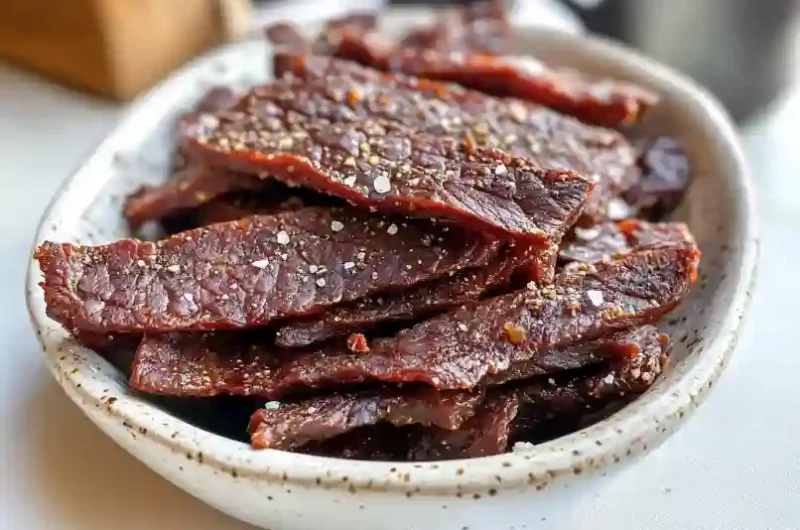The Ultimate High-Protein Snack Guide
Why Athletes Should Ditch the Processed Protein Bars
Learn how to smoke beef jerky for athletes. High-protein, low-carb, and performance-friendly the ultimate recovery snack recipe.
You’ve probably grabbed a protein bar before a workout, right? Maybe even felt a little cheated when you realized it was just a candy bar with extra whey. Here’s the truth: most athletes are fueling with convenience, not performance. And that’s exactly why smoked beef jerky deserves a permanent spot in your gym bag.
Smoked beef jerky isn’t just a snack it’s pure, portable muscle fuel. Each strip is loaded with lean protein, essential minerals like iron and zinc, and virtually zero carbs if you do it right. For athletes chasing recovery gains or sustained endurance, it’s a smarter choice than sugary shakes that spike insulin and crash energy later. And here’s the kicker when you smoke it yourself, you control everything: the cut, the seasoning, even the texture.
So why this guide? Because most jerky recipes online don’t care about performance nutrition. They’re built for taste first, not for your quads or your next PR. Over the next few minutes, I’ll show you:
- The best beef cuts for maximum protein and minimal fat.
- Smoker techniques that preserve nutrients (yes, that’s a thing).
- Athlete-friendly marinades that boost recovery instead of just making it taste good.
And if we’re being honest there’s something deeply satisfying about tearing into jerky you made yourself. It feels primal. Earned. Like the opposite of ripping open another shiny foil bar from the gas station.
Quick Take: Why Athletes Should Smoke Their Own Jerky
Homemade smoked jerky keeps protein high, sugar low, and flavor natural. Plus, you can prep in bulk, saving cash and cutting out mystery ingredients.
How to Smoke Beef Jerky for Athletes
Course: LunchCuisine: AmericanDifficulty: Medium4
servings20
minutes5
hours~120 kcal (Varies by cut)
kcalSmoked Beef Jerky for Athletes A lean, high-protein, low-carb snack designed for muscle recovery, endurance, and clean on-the-go fueling.
Ingredients
2–3 lbs lean beef (eye of round, top round, or sirloin tip)
1/2 cup low-sodium soy sauce or coconut aminos
2 tbsp apple cider vinegar (or lemon juice)
1 tbsp Worcestershire sauce
1 tsp garlic powder
1 tsp onion powder
1/2 tsp black pepper
1/2 tsp cayenne (optional for spice)
1/2 tsp turmeric (optional for recovery boost)
1 tsp honey or maple syrup (optional, for mild sweetness)
Directions
- Prep the Beef
Trim all visible fat.
Partially freeze beef for 1–2 hours for easier slicing.
Slice into 1/4-inch strips:
Against the grain = tender jerky.
With the grain = chewier, longer-lasting jerky - Marinate
Mix all marinade ingredients in a bowl.
Coat beef strips thoroughly, place in a zip bag or covered dish.
Refrigerate 6–12 hours (no longer than 24). - Smoke the Jerky
Preheat smoker to 160–180°F.
Use hickory for classic flavor or applewood for a milder taste.
Arrange strips on smoker racks, leaving space for airflow.
Smoke 4–6 hours, flipping halfway, until jerky bends and cracks slightly but doesn’t snap. - Cool & Store
Cool completely before storing.
Refrigerate in airtight bags for 2–3 weeks, or vacuum-seal for 1–2 months. - Pro Athlete Tips
Post-Workout: Pair 2–3 oz jerky with a banana or rice cakes for optimal recovery.
Endurance Training: Snack on 1 oz every hour to sustain energy.
Meal Prep: Portion into small bags for easy grab-and-go fueling.
Table of Contents
Why Smoked Beef Jerky is a Game-Changer for Athletes
Let’s be real most “high-protein” snacks marketed to athletes are full of fillers, sugars, and preservatives. But smoked beef jerky? It’s about as close to pure performance nutrition as you can get, provided you make it right.
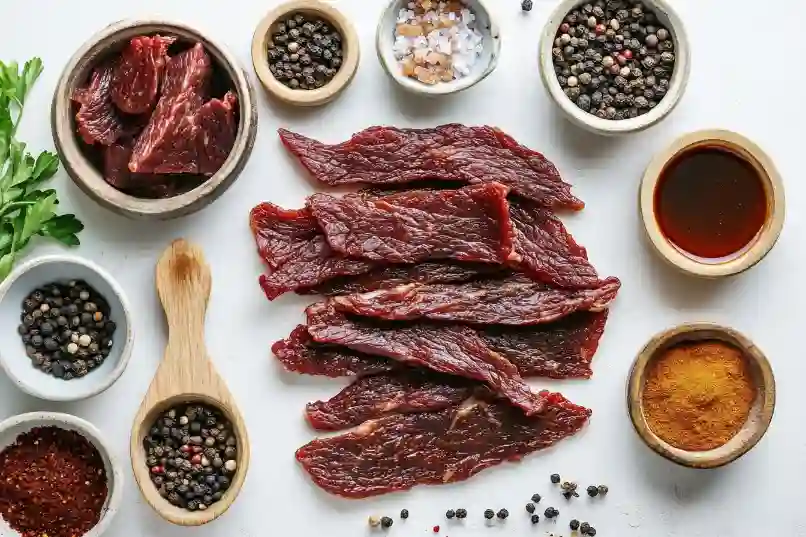
Jerky has been a go-to survival food for centuries because it’s lightweight, shelf-stable, and nutrient-dense. For athletes, that translates to quick recovery fuel and sustained energy without the digestive crash that comes with processed snacks.
Nutritional Benefits That Matter for Training and Recovery
The big win here is protein quality. Lean beef jerky is rich in complete amino acids exactly what your muscles crave post-workout to repair micro-tears and grow stronger. Add in iron, which helps carry oxygen to muscles, and zinc, which supports recovery, and you’ve got a snack that quietly does more for you than that neon-colored sports drink.
Harvard Health Publishing (Harvard Medical School) highlights beef jerky as a protein-rich snack, noting it delivers about 10 g of protein per ounce ideal for muscle recovery, satiety, and supporting strength training in athletes
Here’s a quick breakdown of what makes smoked jerky athlete-friendly:
- High Protein, Low Fat 10–15g of protein per ounce with minimal fat if you pick the right cut.
- No Blood Sugar Spikes Almost zero carbs when made without sugary marinades.
- Portable & Shelf-Stable Perfect for long training days, hikes, or competition travel.
- Customizable for Goals You control sodium, spices, and portion size to match your training cycle.
And this might sound odd but the act of chewing jerky actually slows you down. That’s a hidden advantage. Unlike slamming a shake, eating jerky triggers a longer satiety response, which can help athletes avoid overeating when cutting weight.
When Should Athletes Eat Smoked Beef Jerky?
- Post-Workout: Within 30 minutes after training to kickstart muscle recovery. Pair it with a fast-carb (like a banana) for better glycogen replenishment.
- Mid-Training or Endurance Events: A few strips can help sustain energy during long bike rides, hikes, or tournaments.
- Travel or Busy Days: Jerky works as a protein anchor in meals when you can’t cook.
FAQ: Is Smoked Beef Jerky Good for Muscle Building?
Yes. Because it’s high in leucine (the amino acid that drives muscle protein synthesis), jerky is excellent for muscle repair and growth just make sure you’re eating it as part of a balanced diet with enough total calories to fuel training.
Best Cuts of Beef for Athletic-Grade Jerky
The secret to athlete-approved jerky isn’t just in the marinade or smoking technique it starts with the right cut of beef. The goal? Maximum protein, minimal fat, and a texture that stays tender after smoking.
Most store-bought jerky uses whatever cheap cuts they can find, which often means excess fat (spoils faster) or too much connective tissue (chewy to the point of jaw pain). When you’re smoking your own, you get to be picky and that’s where the magic happens.
Top Lean Cuts for High-Protein Jerky
- Eye of Round Hands down the athlete’s best choice. Super lean, uniform grain for easy slicing, and low cost.
- Top Round (London Broil) Similar to eye of round, slightly more tender, still very lean.
- Sirloin Tip A bit pricier, but the flavor is worth it. Great protein-to-fat ratio.
- Flank Steak Lean with a beefier flavor, but can be tougher if not sliced properly.
Avoid: Brisket or ribeye (too fatty fat goes rancid quickly and doesn’t dry well).
How to Prep Beef for Optimal Smoking
- Trim All Visible Fat: Fat doesn’t dehydrate, and it can turn rancid if stored for weeks.
- Freeze Slightly Before Slicing: A partially frozen slab is easier to cut into uniform thin strips.
- Slice Against the Grain for Tender Jerky: If you want more chew (some athletes prefer it for slower eating), slice with the grain instead.
- Keep Strips 1/4-Inch Thick: Thin enough to dry properly, thick enough to stay meaty.
FAQ: Can I Use Ground Beef for Jerky?
Technically, yes ground beef jerky exists, but it’s not ideal for athletes. It tends to be fattier, less portable, and doesn’t have the same satisfying chew that helps curb hunger between meals. Stick with whole muscle cuts for the best nutrient profile.
How to Smoke Beef Jerky: Step-by-Step Guide
Making smoked beef jerky isn’t complicated but doing it right (so it’s both tasty and performance-friendly) takes a little finesse. The key is balancing low heat, slow drying, and the right seasonings so you preserve protein quality without overdrying the meat into shoe leather.
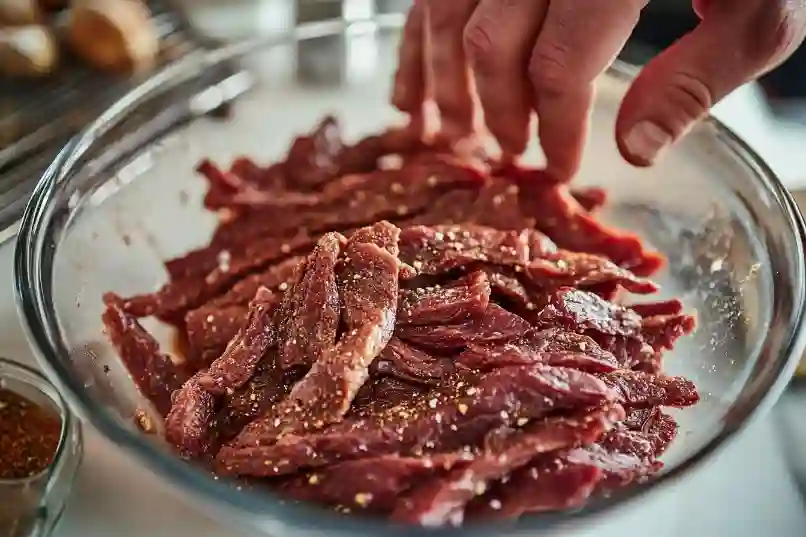
Step 1: Prep & Slice the Beef
- Trim All Fat The leaner, the better.
- Partially Freeze for 1–2 Hours Makes uniform slicing much easier.
- Slice 1/4-Inch Thick Consistent thickness ensures even drying.
- Choose Your Texture:
- Against the grain = tender strips (easier to chew post-workout).
- With the grain = chewier, longer-lasting strips (great for endurance events).
Step 2: Make an Athlete-Friendly Marinade
Skip the sugar-heavy, store-bought marinades. Instead, build flavor with ingredients that actually support recovery:
- Base: Low-sodium soy sauce or coconut aminos (electrolyte-friendly).
- Acid: Apple cider vinegar or lemon juice (helps tenderize).
- Performance Spices:
- Garlic & Onion Powder Natural anti-inflammatory benefits.
- Black Pepper & Cayenne Boosts circulation.
- Turmeric (optional) Recovery-friendly anti-inflammatory.
- Optional Sweetness: A teaspoon of honey or maple syrup (just enough for balance, not sugar overload).
Marinate for 6–12 hours in the fridge. Longer = deeper flavor, but don’t exceed 24 hours or the meat can get mushy.
Step 3: Smoke Low & Slow
- Preheat Smoker: 160–180°F (keep it low to dry, not cook).
- Choose Hardwood:
- Hickory Bold, classic jerky flavor.
- Applewood Mild & slightly sweet (pairs well with recovery-focused spices).
- Mesquite Strong, but can overpower if used too long.
- Lay Strips Flat: Leave space between pieces for airflow.
- Smoke Time: 4–6 hours, depending on thickness. Flip halfway for even drying.
Pro Tip: Jerky is ready when it bends and cracks slightly but doesn’t snap.
Step 4: Cool & Store Like a Pro
- Cool Completely Before Storing Traps less moisture = longer shelf life.
- Refrigerate or Vacuum Seal: Lasts 2 weeks in the fridge, 1–2 months vacuum sealed.
- On-the-Go Packs: Portion into 2–3 oz bags for quick post-workout grabs.
FAQ: Can I Make Jerky in an Oven Instead of a Smoker?
Yes set your oven to its lowest temp (around 170°F), prop the door open slightly for airflow, and dry for 4–5 hours. You won’t get the same smoky depth of flavor, but it works in a pinch.

Pro Tips to Keep It Healthy & Performance-Optimized
Here’s the thing: just because jerky is “homemade” doesn’t automatically make it healthy. For athletes, every ingredient choice can tilt the balance toward recovery fuel or just another salty snack. So, let’s tweak your jerky-making to keep it lean, clean, and competition-ready.
1. Keep Sodium in Check Without Losing Flavor
- Swap regular soy sauce for low-sodium soy or coconut aminos.
- Use herbs and spices (garlic, black pepper, smoked paprika) to build flavor depth instead of relying on salt.
- If you need electrolytes for endurance events, you can keep a little extra sodium but don’t overdo it if you’re eating jerky daily.
2. Ditch Sugar-Heavy Marinades
A lot of “classic” jerky recipes drown in brown sugar or teriyaki sauce. Problem? Blood sugar spikes → energy crashes.
- Use just 1 tsp honey or maple syrup for balance or skip it entirely if you’re strict low-carb.
- Try umami boosters like Worcestershire sauce or mushroom powder to add richness without sweetness.
3. Use Recovery-Boosting Spices
Athletes overlook this, but certain spices have real performance benefits:
- Turmeric + Black Pepper → Anti-inflammatory combo for sore muscles.
- Cayenne → Boosts circulation, which can speed recovery.
- Ginger Powder → Aids digestion and reduces post-training muscle soreness.
4. Portion Like an Athlete, Not a Snacker
- Post-Workout: 2–3 oz paired with a carb source for glycogen replenishment.
- Endurance Events: Smaller 1 oz portions every hour to avoid stomach heaviness.
- Cutting/Weight Management: 1 oz at a time, chew slowly to increase satiety.
FAQ: Can Jerky Be Too Lean for Athletes?
Technically, yes a little fat helps with satiety and hormone health. If you’re deep into a cutting phase, stick to very lean cuts, but if you’re in a muscle-building phase, leaving a tiny bit of intramuscular fat (like in top sirloin) can actually help recovery by slowing protein digestion slightly.
Storage & Meal Prep for Busy Athletes
The best part about smoked beef jerky besides the flavor is how easy it is to keep on hand for training days, road trips, or long competitions. But storage matters. Done wrong, even the leanest jerky can spoil or lose its chew.
Think of this section as your jerky logistics plan: how to prep in bulk, keep it fresh, and always have a performance-friendly snack ready.
How Long Does Smoked Beef Jerky Last?
- Room Temperature (Airtight Bag): 1 week (great for short trips or gym bag storage).
- Refrigerated: 2–3 weeks if stored in a zip-top bag with minimal air.
- Vacuum-Sealed & Refrigerated: 1–2 months ideal for meal preppers.
- Frozen: Up to 6 months (texture may change slightly, but still great for bulk prep).
Pro Tip: Always cool jerky completely before sealing trapping warm moisture = bacteria growth.
Portioning for Training & Competitions
- Post-Workout Packs: Pre-portion 2–3 oz servings in small resealable bags or reusable silicone pouches.
- Endurance Training Packs: 1 oz snack-size portions to eat hourly.
- Daily Meal Prep: Use jerky as a “protein add-on” toss strips into salads, wraps, or even scrambled eggs for a quick boost.
Best Way to Carry Jerky On-the-Go
- Use vacuum-sealed snack packs if traveling for tournaments.
- For gym use, keep jerky in a resealable bag with a silica gel packet (food-safe, keeps moisture out).
- If hiking or racing, pack jerky with a small carb source (like dried fruit or rice cakes) to balance energy.
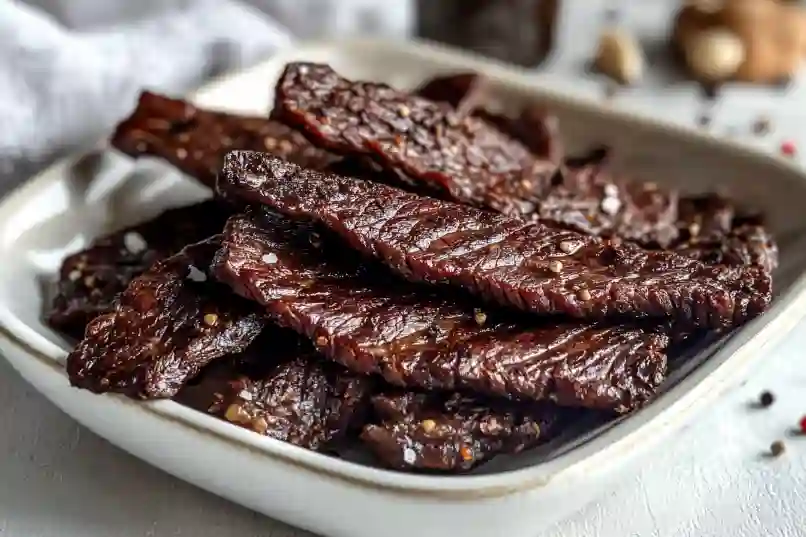
FAQ: Can I Meal Prep Jerky for the Whole Month?
Yes if you vacuum-seal and refrigerate or freeze it. For athletes who train daily, prepping once a month is a huge time-saver. Just thaw portions overnight in the fridge, and they’re good to go.
FAQ: Smoking Beef Jerky for Fitness Goals
Even with the step-by-step guide, athletes still have questions about how smoked beef jerky fits into their nutrition plan. Here are the most common ones answered straight and simple.
Is Smoked Beef Jerky Good for Weight Loss?
Yes, if you choose lean cuts and keep marinades low in sugar. Jerky is high in protein, which boosts satiety, meaning you’ll feel fuller longer. Just watch portion sizes it’s easy to overeat because it’s so convenient.
Can Jerky Replace a Protein Shake Post-Workout?
Not entirely. Shakes digest faster, which can be beneficial immediately after intense lifting. But jerky works great if you’re pairing it with a fast carb (like a banana or rice cakes). Think of it as a solid food alternative, especially for athletes who don’t want liquid meals all day.
How Much Jerky Should Athletes Eat Daily?
- Recovery Phase or Muscle Building: 2–4 oz per day is fine, spread out across meals.
- Cutting or Weight Maintenance: 1–2 oz as a snack or meal add-on.
Anything beyond that, and you risk eating too much sodium or not getting enough variety in your diet.
Will Smoking Beef Reduce Its Protein Quality?
Not significantly if you keep temperatures low (160–180°F). High heat for long periods can denature proteins slightly, but smoked jerky still retains almost all of its amino acid profile.
Can I Smoke Jerky Without Fancy Equipment?
Absolutely. An oven, dehydrator, or even a grill with indirect heat works. You won’t get the same smoky depth, but for nutrition purposes, it’s just as effective.
Build Your Own Athlete Fuel
Let’s be honest once you’ve made smoked beef jerky yourself, you’ll never look at those overpriced, sugar-loaded store-bought packs the same way again. You’ll know exactly what’s in your snack, you’ll trust every bite, and maybe the best part you’ll feel like you’ve earned it.
For athletes, this isn’t just about taste. It’s about owning your nutrition. Every strip of jerky you smoke is a deliberate choice: lean protein to repair your muscles, clean spices to support recovery, and portion sizes that work for your training plan. No guessing, no fillers, no marketing fluff just real fuel for real performance.
So, whether you’re gearing up for a marathon, chasing new PRs in the gym, or just need a reliable snack that won’t sabotage your macros, smoked beef jerky might be one of the simplest, smartest tools you can add to your athlete toolbox.
And here’s the kicker it’s not just fuel; it’s a ritual. The slicing, the marinade, the slow smoking… it feels like investing in your own progress. You’re not just eating; you’re preparing to win.
And if you’re hungry for more, check out our other How to Cook Turkey Ribs For a High-Protein Meal perfect for cozy nights and nourishing routines
This recipe (How to Smoke Beef Jerky for Athletes) is intended for informational and meal-planning purposes only. Nutritional values are estimated based on standard ingredient brands and serving sizes; actual values may vary. Always consult with a registered dietitian or healthcare professional before making significant changes to your diet, especially if you have underlying health conditions or specific fitness goals. This meal is not intended to diagnose, treat, or cure any medical condition

